|
Harvest all
the way
It is payback
time in Punjab. Paddy fields are laden with hi-tech harvesters
and farmers are busy reaping the produce of their investment. A.J.
Philip traverses the Malwa belt to present the grainy
flavour of the season
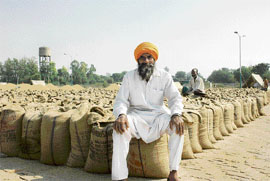
PICTURE PERFECT: Content after the labour |
A
VISIT to Bathinda, even if it is for as prosaic a reason as
meeting colleagues, is not complete without a visit to the
Gobind Fort in the heart of one of the oldest cities of Punjab.
The fort, that resembles a ship in a desert, has withstood the
vicissitudes of time, though it could not always save its
occupants from invaders in its eventful history that spans a
millennium.
Today more
people visit the fort to pay obeisance at the gurdwara there
that traces its origin to Guru Gobind Singh, who challenged the
Mughals from the forests in the area, than to see the
architectural marvel. Four years ago when I visited the fort the
first time, restoration work was on to save its crumbling walls.
The work has
saved some portions of the fort while there are areas within the
rectangular enclave that calls for a similar save-the-heritage
initiative. More than the imposing edifice, what attracted my
attention was the large number of doves having a hearty meal in
the enclosure for them in front of the fort.
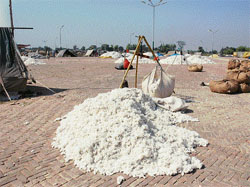
MORE THAN FLUFF: Cotton has started arriving in Mansa mandi |
The faithful
replenish the grains as quickly as the birds finish them. Alone
in the crowd was a suspicious crow which ate stealthily to its
belly’s content. As I moved nearer to get a close-up shot of
the crow surrounded by the doves, they all flew away in a
flutter. My patient wait in the sun was not in vain as the birds
returned one by one but the crow kept aloof, denying me my
award-winnable photograph.
Nobody knows
for sure how Bathinda became a hub of coaching institutes, which
attract thousands of students from far and wide. A large
hoarding of an airhostess academy that overlooks the ‘virgin
soil upturned’, where a flyover will soon come up, shows that
the ever-enterprising entrepreneurs have thought of new, niche
job-oriented courses to attract the youth.
On the way to
Talwandi Sabo, vineyards on both sides of the road caught my
attention. "Fruits of all kinds grow in this area",
said the driver pointing out a garden of kinnows. Even from a
distance, the trees laden with kinnows were a sight to behold.
Next to the kinnow garden was another one of guava.
Racing past
fruit gardens and beehives, the Malwa belt, as it is known,
reminded me of Canaan, about which I learnt at Sunday School.
However, it is the cultivation of cotton that keeps the rural
economy in this part of the state alive and kicking. This year,
too, the cotton crop is said to be bountiful.
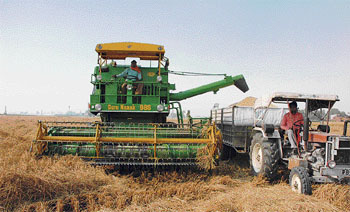 |
With labour cost hitting the ceiling, there is no alternative to mechanisation. Farmers need not even own a harvester as they can hire it. But for those who hold small farms where every family member works side by side with hired labour, harvesting is still done the manual way. Now, they too find it economical to hire harvesters. |
The driver
stopped the car at a cotton field to pluck some cotton bolls for
me. My grandfather was also a cotton cultivator in the sense he
had a few cotton trees in his farm. They were big trees and the
bolls, too, were larger than the ones I saw at Bathinda.
Unlike the
Kerala variety, Bt Cotton plants give a better, quick-yielding
crop. Unlike other cash crops like vanilla and rubber for which
artificial substitutes have been found, much to the chagrin of
the farmers, no substitute has yet been found for cotton. The
Bathinda farmer, in fact, rejoices over the failure of the
"white man", who has successfully kept the prices of
Indian spices at what they used to be during the East India
Company days. In fact, 300 years ago, the Dutch considered
pepper more precious than gold.
In the Malwa
region, the gurdwara at Talwandi Sabo, declared in the 1960s as
one of the five Takhts of the Sikhs, is the most sacred. It was
here that Guru Gobind Singh composed most of the hymns that are
attributed to him.
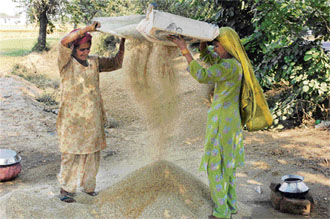
For a morsel of grain: Two women winnowing waste paddy |
The gurdwara
precincts were in a mess because of some construction work when
I visited it the previous time. The work was almost over and the
shrine was at its resplendent best. It was a coincidence that
the visit was on the Dasehra day, when the Malayalees
traditionally initiate children into learning. For the Sikhs,
Talwandi Sabo is the seat of knowledge.
It is believed
that those who write the Gurmukhi alphabet on sand in the
designated area near the lake would become "brainy".
Whatever be the truth of the belief, for the extremely fat child
of an obese father, who was compelled to bow down and write all
the letters of the alphabet, the exercise would have made a
beneficial impact on his body, if not his brain. If the son had
insisted on his father showing him how to squat, bow down and
write all those letters on the sand, he could surely have
escaped the torture.
Back on the
road to Chandigarh, we suddenly noticed a cotton mandi. When we
drove in, the farmers who had brought their produce rushed to
offer us a "competitive" price but the moment they saw
my camera, they knew we were not traders and they returned to
the comfort of the tiny temporary sheds in the mandi. Why brave
the sun and waste their energy for a God-knows-from-where
journalist, they must have thought.
A short drive
and we were at Mehla Chowk. Two old women were winnowing paddy
on the roadside. The moment we stopped the car, they, too,
stopped work. The driver and I had to use all our persuasive
skills, which amounted to virtual begging, to get them to
restart their work.
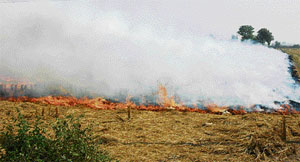
BIG BLOT: The ban on burning of paddy residue is flouted at many a place |
Lest the women
should have second thoughts, I clicked them in a hurry. They
must have realised that taking their photographs did not expose
them to any risk. The more aggressive of the two suddenly became
apologetic and told me, "We are poor people. This is the
waste material that we collected from the mandi. It is mostly
husk. We winnow it and recover whatever little broken grain it
contains. We know you will send these photographs abroad and get
a lot of money but we are poor people who survive on the
leftovers".
Her comment
moved me only when the driver translated the words into Hindi.
The mandi nearby was a beehive of activity. Tractors were
unloading grain, which after winnowing and weighing was being
packed in gunny bags.
It was the
fifth day since paddy had begun arriving at the mandi. It would
continue for another 10-12 days. One of the farmers was more
interested in finding out which television channel I represented
than answering my simple queries. He wanted to know the channel’s
name so that he could check the transmission.
One of them
seemed to have a great photographic sense as he sat on the grain
bags at such an angle that the photograph met all the
requirements of good composition. He was so pleased with the
picture that I had to struggle out of his invitation to have a
cup of tea with him.
It was
harvesting time in Malwa. Huge harvesters, the kind of which I
had never seen, crisscrossed on the main road. I wanted to see a
harvester in operation. We did not have to drive long to find a
harvester at work near the highway. Operated by one person, the
harvester did many things at the same time.
It cut the
plants and threshed them. While the grain is stored in a
container on the machine, the hay is thrown out. It did such a
neat job that the bundle of hay that I checked did not have even
a single grain.
At the press of
a button, the grain is pumped out through a pipe into a
tractor-trailer to be transported out of the field. The
multi-tasking machine does a quick job, depriving many labourers
of employment. With labour cost hitting the ceiling, there is no
alternative to mechanisation. Farmers need not even own the
harvester as they can hire it.
But for those
who hold small farms where every family member works side by
side with hired labour, harvesting is still done the manual way.
Now, they too find it economical to hire harvesters. Thus,
Punjabi farmers doing the bhangra on the fields during the
harvesting season is more in the imagination than in reality.
Machines have already replaced man.
Bhavanigarh is
a small, non-descript town in Sangrur district. We would have
sped past the town but for an unusual sight. I saw little shops
selling miniature trucks, cars, buses and tractors on the
roadside. Generations of carpenters and artisans in the area
have been making these toys, which are unique in many ways.
They are not
like the remote-controlled Chinese trucks and cars that run and
stop at the touch of a button for as long as God knows. The
Bhavanigarh truck, pulled by a string, runs as fast as the child
runs and it does not need any battery or lubrication. The child
can fill it with his goods and carry it from one room to another
or around his house.
The child will eventually
outgrow the truck, which he can keep for his own child. And all
this for a small price! The artisans have also begun making
metallic tractors. "However, to get the feel of Bhavanigarh,
you should buy a wooden toy", advised a shopkeeper. Alas, I
did not remember my colleague-cum-neighbour’s daughter, who
would have loved to receive one, when hunger and exhaustion
forced me to return to the car and continue the journey back to
Chandigarh.

|